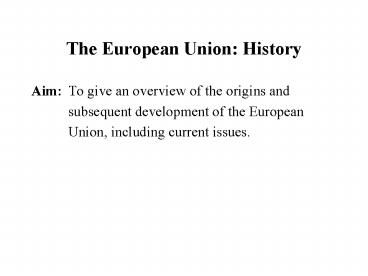The European Union: History PowerPoint PPT Presentation
1 / 18
Title: The European Union: History
1
The European Union History
- Aim To give an overview of the origins and
- subsequent development of the European
- Union, including current issues.
2
The European Union History (cont.)
- 1. How many member states are there in the EU?
- 2. List the EU member states.
3
The European Union History (cont.)
- Origins
- 1945 End of WWII
- 1949 Council of Europe
- NOT an EU institution
- intergovernmental consultative institution
- 40 member countries
- focus on human rights, education, culture,
- environment
4
Origins (cont.)
- important objective avoid further European wars
- tentative plans for political unity
- economic objectives were means to achieve this
5
Origins (cont.)
- Differences in positions
- UK links with Commonwealth USA
- Scandinavian countries neutrality (Cold War)
- Southern Europe E P dictatorships
- G possible link w.Soviet Union
- France and Germany formed alliance
- -Italy and Benelux countries in support
- -European unity a political issue
- -UK and Scandinavian countries economic view
6
Origins (cont.)
- 1951 European Coal and Steel Community (ECSC)
Treaty of Paris (B, F, D, I, L, NL) - - Aim to integrate German heavy industries
into European structure. - 1957 European Economic Community (EEC)
- Treaty of Rome
- Which countries were the founder members ?
7
Origins (cont.)
- 1960 European Free Trade Association (EFTA)
- UK, A, CH, N, S, DK, P.
- free trade area.
- EEC elements of supranationality in
decision-making - EFTA less ambitious, economic not political
perspective.
8
Development
- 1973 first enlargement
- Which country/ies joined?
- 1981 second enlargement
- Which country/ies joined?
- 1995 third enlargement
- Which country/ies joined?
9
Development (cont.)
- Other Developments
- 1962 Launch of the Common Agricultural Policy
- (CAP)
- 1968 Completion of customs union (no internal
tariffs, common external tariff) - 1972 Snake in the tunnel form of exchange
rate mechanism - 1970s period of stagnation
- - instability of internat. monetary system
- - oil price increases
10
Other Developments (cont.)
- 1984 establishment of free trade area
- between EC and EFTA
- 1986 Single European Act (SEA)
- - start of Single European Market (SEM) prog.
- - extends Community competence to
- - environmental policy
- - economic and social cohesion
- - research and technology policy
- - social policy
11
Other Developments (cont.)
- 1992 Treaty on European Union (Maastricht
Treaty) - - EC becomes known as EU
- - Completion of SEM (31 December)
- 1999 Launch of single currency (euro)
- - transition period 1999 - 2002
- Which countries are participating?
12
Current Issues
- Enlargement
- Agenda 2000 (1997)- programme for next wave of
enlargement - Includes up to ten central and east European
- countries (CEECs), Cyprus and Malta.
- Many more applicant countries than in previous
- enlargements
- Differences between countries greater than ever
- before
13
Enlargement (cont.)
- Admissions will be staggered, depending on level
of development - All ten CEECs will be net recipients of EU
funding - Increase in EU population from 372 (EU15) to 477
m - Enlargement necessitates institutional and
procedural reforms
14
Enlargement (cont.)
- Population (m) GDP per capita ( EU 15)
- Slovenia 2.0 72
- Czech Republic 10.3 60
- Hungary 10.0 52
- Slovakia 5.4 48
- Poland 38.6 39
- Estonia 1.4 38
- Latvia 2.4 29
- Lithuania 3.7 29
- Romania 22.4 27
- Bulgaria 8.2 24
- (Eur. Comm.)
15
Enlargement (cont.)
- Conditions for entry
- Stability of democratic institutions
- Functioning market economy
- Ability to comply with the obligations of
membership (including political, economic and
monetary union) - -Requirement to incorporate acquis
communautaire into national law - -Transition periods for each applicant state to
be discussed in entry negotiations
16
Enlargement (cont.)
- most applicants satisfy the political criteria
(1993 Copenhagen summit), except Turkey - all applicants functioning market economies,
except Romania, Bulgaria is close - BUT much progress still necessary by all
applicant countries.
17
Enlargement (cont.)
- EU reforms required
- CAP
- Institutions
- Procedures
- Possible outcome
- Big Bang accession of 10/13 in 2005/6?
- ENLARGEMENT IRREVERSIBLE
18
Summary
- Origins of the European Union
- Development of the European Union
- Current Issues Enlargement of the European Union

